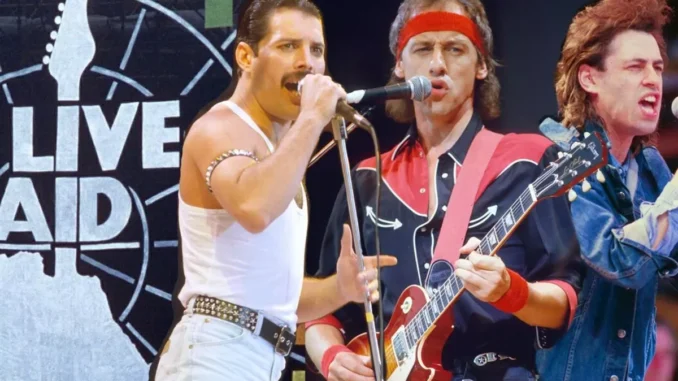
Live Aid Turns 40: Reliving the Epic Day Music Stopped Time and United the Planet…Read More…
Forty years ago today, the world stood still as music became more than just a form of entertainment—it became a force of global unity, compassion, and change. On July 13, 1985, the Live Aid concert sent shockwaves through history, raising not just over $125 million for famine relief in Africa, but also proving that music could speak louder than politics, conflict, and distance.
Now, four decades later, the echoes of that unforgettable day still resonate. Fans, artists, and activists across the globe are marking the anniversary with tributes, documentaries, and commemorative performances—reminding everyone of the raw emotional power and global impact Live Aid unleashed.
A Dream That Became a Global Phenomenon
Conceived by Irish musician Bob Geldof and Midge Ure of Ultravox, Live Aid was born out of desperation and outrage. Geldof had been deeply moved—and horrified—by BBC footage of the Ethiopian famine, which left over a million people dead. Refusing to stand idle, he began organizing a global fundraising concert at lightning speed.
What followed on that July day in 1985 was nothing short of miraculous. Two massive, simultaneous concerts were held—one at Wembley Stadium in London and the other at John F. Kennedy Stadium in Philadelphia. Together, they attracted an estimated 1.9 billion viewers across 150 countries—nearly 40% of the world’s population at the time.
The Day the Stars Aligned
The lineup for Live Aid read like a musical Mount Rushmore. In London, Queen, led by the inimitable Freddie Mercury, delivered what many critics and fans still call the greatest live performance in rock history. Their 21-minute set turned Wembley into a cathedral of rhythm, unity, and sheer charisma.
David Bowie, U2, The Who, Elton John, Paul McCartney, and Sting were among the luminaries who graced the London stage, while in Philadelphia, the likes of Led Zeppelin (with Phil Collins playing drums for both cities), Madonna, Bob Dylan, Tina Turner, Eric Clapton, and Mick Jagger electrified American audiences.
Each performance was more than just music—it was a rallying cry, a plea, a promise that humanity could come together and make a difference.
Behind the Scenes: Chaos, Collaboration, and Courage
While the concerts appeared seamless on screen, the behind-the-scenes reality was anything but. Equipment failures, tight turnarounds, last-minute schedule changes, and the immense pressure of broadcasting live to the world all loomed like thunderclouds.
Phil Collins famously flew on the Concorde from London to Philadelphia to perform at both venues on the same day. Queen’s set was so tightly choreographed that it became a case study in performance excellence. Meanwhile, volunteers and organizers worked tirelessly around the clock to ensure donations were collected and aid was distributed fairly and effectively.
In today’s social media era, it’s hard to comprehend how a massive, coordinated event like Live Aid could be executed with no email, limited international phone lines, and minimal digital infrastructure. But it was done—driven purely by conviction, creativity, and courage.
The Legacy: A Blueprint for Change
Live Aid wasn’t just a moment—it became a movement. In its wake, organizations like Band Aid, USA for Africa, and Comic Relief expanded their efforts. The concert’s visibility forced world leaders to acknowledge the famine crisis more seriously, ultimately influencing international aid policies.
Even critics who questioned the logistics of aid distribution couldn’t deny the awakening Live Aid triggered. It inspired generations of artists to use their platforms for activism and humanitarian work. Bono, for example, has credited Live Aid with shaping his lifelong commitment to social justice.
The event also set the stage for future benefit concerts—like 2005’s Live 8, also spearheaded by Geldof, which aimed to pressure G8 leaders into canceling debt for the world’s poorest countries.
40 Years Later: A World Remembers
Today, as the 40th anniversary of Live Aid is commemorated, the spirit of the concert remains very much alive. Special tributes are being held in London, Philadelphia, and cities worldwide. A 4K remastered version of the original concert footage is being released on major streaming platforms, and a star-studded documentary—Live Aid: The Day the World Sang in Unison—is topping charts on Netflix.
Elton John, now in his seventies, reflected during a BBC interview: “We weren’t just playing music. We were showing the world that we could stand together when it mattered most. And we did. It was magic.”
Younger artists like Billie Eilish, Ed Sheeran, and BTS have also paid tribute on social media, posting clips of their favorite Live Aid moments and speaking about the importance of using fame to fight injustice.
The Enduring Question: Can Music Still Do That?
As global challenges in 2025 continue to mount—climate change, poverty, war, and displacement—the question many are asking is: can music still move the world the way it did in 1985?
Bob Geldof, never one to mince words, recently responded, “It can. It must. If anything, it’s even more urgent now. Live Aid wasn’t a miracle—it was proof of what we can do when we give a damn.”
Indeed, as the world pauses to remember that extraordinary day 40 years ago, we are reminded that music, at its best, is not just entertainment—it’s empathy in motion, and perhaps our most universal language of hope.
Leave a Reply